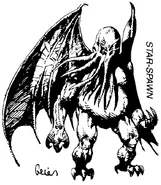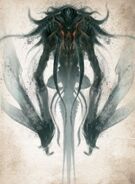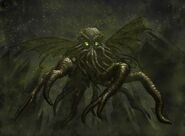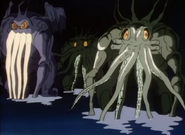- "These Great Old Ones, Castro continued, were not composed altogether of flesh and blood. They had shape - for did not this star-fashioned image prove it? - but that shape was not made of matter. When the stars were right, They could plunge from world to world through the sky; but when the stars were wrong, They could not live. But although They no longer lived, They would never really die. They all lay in stone houses in Their great city of R’lyeh, preserved by the spells of mighty Cthulhu for a glorious resurrection when the stars and the earth might once more be ready for Them. But at that time some force from outside must serve to liberate Their bodies. The spells that preserved Them intact likewise prevented Them from making an initial move, and They could only lie awake in the dark and think whilst uncounted millions of years rolled by. They knew all that was occurring in the universe, but Their mode of speech was transmitted thought. Even now They talked in Their tombs. When, after infinities of chaos, the first men came, the Great Old Ones spoke to the sensitive among them by moulding their dreams; for only thus could Their language reach the fleshly minds of mammals."
- ―Francis Wayland Thurston, relating what Old Castro told Inspector Legrasse in 1907.
The Star Spawn of Cthulhu, sometimes also known as Xothians and referred to as the "Great Old Ones" by Cthulhu cultists such as Old Castro, are an extraterrestrial civilization of land-based octopus-like beings which colonized Earth sometime during the Paleozoic era and fought a long-lasting war against the Elder Things, eventually causing their opponents' withdrawal to the sea. Later, peace treaties were made granting most of the recently formed continental areas of Earth to the Spawn of Cthulhu, while the oceans and the older lands—notably the Antarctic continent—were left to the Elder Things. The Spawn of Cthulhu was so called for worshiping the Great Old One known as Cthulhu, whose exact relationship to them is still unclear.
Like the Mi-Go but unlike the Elder Things, the Spawn of Cthulhu are not made out of ordinary matter at all, and seem to possess shape-shifting abilities to some degree. They were noted for the non-Euclidean geometry and strange angles of their architecture. Unfortunately for them, most of the land areas that belonged to the Spawn of Cthulhu ended up sinking back to the sea, including their most sacred stone city of R'lyeh, where Cthulhu himself still lies dormant. While the origins of the octopoid creatures is not clear, two hypothesis could be speculated upon: that they were a species that simply happened to be extremely devoted to Cthulhu (who as should be noted shares some cephalopod traits with them) or that they were created by him, perhaps even as true offspring. The fact that some other Great Old Ones also appear to have "follower races" (such as Dagon, who is worshiped by the Deep Ones, and Bokrug by the Thuum'ha); might support this idea.
Appearances[]
- "The Call of Cthulhu", by H. P. Lovecraft (1928) (First mentioned)
- "Through the Gates of the Silver Key", by H. P. Lovecraft and E. Hoffmann Price (1934) (Mentioned only)
- At the Mountains of Madness, by H. P. Lovecraft (1936) (described in the art works of the Elder Things)
Gallery[]
Notes[]
- While "The Call of Cthulhu" uses the term "Great Old Ones" to refer to this species, the term has since become far more associated with the pantheon of cosmic deities of which Cthulhu himself is the most famous member.



